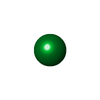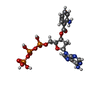[English] 日本語
 Yorodumi
Yorodumi- PDB-1lvc: Crystal structure of the adenylyl cyclase domain of anthrax edema... -
+ Open data
Open data
- Basic information
Basic information
| Entry | Database: PDB / ID: 1lvc | ||||||
|---|---|---|---|---|---|---|---|
| Title | Crystal structure of the adenylyl cyclase domain of anthrax edema factor (EF) in complex with calmodulin and 2' deoxy, 3' anthraniloyl ATP | ||||||
 Components Components |
| ||||||
 Keywords Keywords |  LYASE / helical domain / protein-protein complex LYASE / helical domain / protein-protein complex | ||||||
| Function / homology |  Function and homology information Function and homology information regulation of store-operated calcium channel activity / regulation of high voltage-gated calcium channel activity / calcium- and calmodulin-responsive adenylate cyclase activity / calmodulin dependent kinase signaling pathway / : / regulation of response to tumor cell / positive regulation of autophagic cell death / DAPK1-calmodulin complex / regulation of store-operated calcium channel activity / regulation of high voltage-gated calcium channel activity / calcium- and calmodulin-responsive adenylate cyclase activity / calmodulin dependent kinase signaling pathway / : / regulation of response to tumor cell / positive regulation of autophagic cell death / DAPK1-calmodulin complex /  adenylate cyclase / adenylate cyclase /  : ... : ... regulation of store-operated calcium channel activity / regulation of high voltage-gated calcium channel activity / calcium- and calmodulin-responsive adenylate cyclase activity / calmodulin dependent kinase signaling pathway / : / regulation of response to tumor cell / positive regulation of autophagic cell death / DAPK1-calmodulin complex / regulation of store-operated calcium channel activity / regulation of high voltage-gated calcium channel activity / calcium- and calmodulin-responsive adenylate cyclase activity / calmodulin dependent kinase signaling pathway / : / regulation of response to tumor cell / positive regulation of autophagic cell death / DAPK1-calmodulin complex /  adenylate cyclase / adenylate cyclase /  : / establishment of protein localization to mitochondrial membrane / cAMP biosynthetic process / type 3 metabotropic glutamate receptor binding / establishment of protein localization to membrane / : / establishment of protein localization to mitochondrial membrane / cAMP biosynthetic process / type 3 metabotropic glutamate receptor binding / establishment of protein localization to membrane /  adenylate cyclase activity / adenylate cyclase activity /  CaM pathway / Cam-PDE 1 activation / Sodium/Calcium exchangers / Calmodulin induced events / Reduction of cytosolic Ca++ levels / Activation of Ca-permeable Kainate Receptor / host cell cytosol / CREB1 phosphorylation through the activation of CaMKII/CaMKK/CaMKIV cascasde / regulation of synaptic vesicle endocytosis / Loss of phosphorylation of MECP2 at T308 / CREB1 phosphorylation through the activation of Adenylate Cyclase / PKA activation / negative regulation of high voltage-gated calcium channel activity / regulation of synaptic vesicle exocytosis / CaMK IV-mediated phosphorylation of CREB / Glycogen breakdown (glycogenolysis) / negative regulation of calcium ion export across plasma membrane / organelle localization by membrane tethering / Activation of RAC1 downstream of NMDARs / regulation of cardiac muscle cell action potential / mitochondrion-endoplasmic reticulum membrane tethering / CLEC7A (Dectin-1) induces NFAT activation / autophagosome membrane docking / positive regulation of ryanodine-sensitive calcium-release channel activity / Negative regulation of NMDA receptor-mediated neuronal transmission / CaM pathway / Cam-PDE 1 activation / Sodium/Calcium exchangers / Calmodulin induced events / Reduction of cytosolic Ca++ levels / Activation of Ca-permeable Kainate Receptor / host cell cytosol / CREB1 phosphorylation through the activation of CaMKII/CaMKK/CaMKIV cascasde / regulation of synaptic vesicle endocytosis / Loss of phosphorylation of MECP2 at T308 / CREB1 phosphorylation through the activation of Adenylate Cyclase / PKA activation / negative regulation of high voltage-gated calcium channel activity / regulation of synaptic vesicle exocytosis / CaMK IV-mediated phosphorylation of CREB / Glycogen breakdown (glycogenolysis) / negative regulation of calcium ion export across plasma membrane / organelle localization by membrane tethering / Activation of RAC1 downstream of NMDARs / regulation of cardiac muscle cell action potential / mitochondrion-endoplasmic reticulum membrane tethering / CLEC7A (Dectin-1) induces NFAT activation / autophagosome membrane docking / positive regulation of ryanodine-sensitive calcium-release channel activity / Negative regulation of NMDA receptor-mediated neuronal transmission /  nitric-oxide synthase binding / regulation of cell communication by electrical coupling involved in cardiac conduction / Unblocking of NMDA receptors, glutamate binding and activation / negative regulation of peptidyl-threonine phosphorylation / Synthesis of IP3 and IP4 in the cytosol / Phase 0 - rapid depolarisation / protein phosphatase activator activity / RHO GTPases activate PAKs / nitric-oxide synthase binding / regulation of cell communication by electrical coupling involved in cardiac conduction / Unblocking of NMDA receptors, glutamate binding and activation / negative regulation of peptidyl-threonine phosphorylation / Synthesis of IP3 and IP4 in the cytosol / Phase 0 - rapid depolarisation / protein phosphatase activator activity / RHO GTPases activate PAKs /  small molecule binding / calcium channel regulator activity / positive regulation of cyclic-nucleotide phosphodiesterase activity / positive regulation of phosphoprotein phosphatase activity / small molecule binding / calcium channel regulator activity / positive regulation of cyclic-nucleotide phosphodiesterase activity / positive regulation of phosphoprotein phosphatase activity /  Long-term potentiation / Ion transport by P-type ATPases / Uptake and function of anthrax toxins / Long-term potentiation / Ion transport by P-type ATPases / Uptake and function of anthrax toxins /  adenylate cyclase binding / Calcineurin activates NFAT / Regulation of MECP2 expression and activity / adenylate cyclase binding / Calcineurin activates NFAT / Regulation of MECP2 expression and activity /  catalytic complex / DARPP-32 events / detection of calcium ion / Smooth Muscle Contraction / negative regulation of ryanodine-sensitive calcium-release channel activity / RHO GTPases activate IQGAPs / cellular response to interferon-beta / regulation of cardiac muscle contraction / calcium channel inhibitor activity / regulation of cardiac muscle contraction by regulation of the release of sequestered calcium ion / positive regulation of DNA binding / catalytic complex / DARPP-32 events / detection of calcium ion / Smooth Muscle Contraction / negative regulation of ryanodine-sensitive calcium-release channel activity / RHO GTPases activate IQGAPs / cellular response to interferon-beta / regulation of cardiac muscle contraction / calcium channel inhibitor activity / regulation of cardiac muscle contraction by regulation of the release of sequestered calcium ion / positive regulation of DNA binding /  Protein methylation / enzyme regulator activity / Protein methylation / enzyme regulator activity /  voltage-gated potassium channel complex / voltage-gated potassium channel complex /  phosphatidylinositol 3-kinase binding / Activation of AMPK downstream of NMDARs / eNOS activation / regulation of release of sequestered calcium ion into cytosol by sarcoplasmic reticulum / regulation of calcium-mediated signaling / positive regulation of protein dephosphorylation / phosphatidylinositol 3-kinase binding / Activation of AMPK downstream of NMDARs / eNOS activation / regulation of release of sequestered calcium ion into cytosol by sarcoplasmic reticulum / regulation of calcium-mediated signaling / positive regulation of protein dephosphorylation /  titin binding / regulation of ryanodine-sensitive calcium-release channel activity / Tetrahydrobiopterin (BH4) synthesis, recycling, salvage and regulation / Ion homeostasis / positive regulation of protein autophosphorylation / potassium ion transmembrane transport / sperm midpiece / response to amphetamine / titin binding / regulation of ryanodine-sensitive calcium-release channel activity / Tetrahydrobiopterin (BH4) synthesis, recycling, salvage and regulation / Ion homeostasis / positive regulation of protein autophosphorylation / potassium ion transmembrane transport / sperm midpiece / response to amphetamine /  calcium channel complex / activation of adenylate cyclase activity / substantia nigra development / adenylate cyclase activator activity / Ras activation upon Ca2+ influx through NMDA receptor / calcium channel complex / activation of adenylate cyclase activity / substantia nigra development / adenylate cyclase activator activity / Ras activation upon Ca2+ influx through NMDA receptor /  regulation of heart rate / nitric-oxide synthase regulator activity / protein serine/threonine kinase activator activity / regulation of heart rate / nitric-oxide synthase regulator activity / protein serine/threonine kinase activator activity /  sarcomere / FCERI mediated Ca+2 mobilization / FCGR3A-mediated IL10 synthesis / VEGFR2 mediated vascular permeability / positive regulation of peptidyl-threonine phosphorylation / Antigen activates B Cell Receptor (BCR) leading to generation of second messengers sarcomere / FCERI mediated Ca+2 mobilization / FCGR3A-mediated IL10 synthesis / VEGFR2 mediated vascular permeability / positive regulation of peptidyl-threonine phosphorylation / Antigen activates B Cell Receptor (BCR) leading to generation of second messengersSimilarity search - Function | ||||||
| Biological species |   Bacillus anthracis (anthrax bacterium) Bacillus anthracis (anthrax bacterium)  Homo sapiens (human) Homo sapiens (human) | ||||||
| Method |  X-RAY DIFFRACTION / X-RAY DIFFRACTION /  SYNCHROTRON / SYNCHROTRON /  FOURIER SYNTHESIS / Resolution: 3.6 Å FOURIER SYNTHESIS / Resolution: 3.6 Å | ||||||
 Authors Authors | Shen, Y. / Lee, Y.-S. / Soelaiman, S. / Bergson, P. / Lu, D. / Chen, A. / Beckingham, K. / Grabarek, Z. / Mrksich, M. / Tang, W.-J. | ||||||
 Citation Citation |  Journal: Embo J. / Year: 2002 Journal: Embo J. / Year: 2002Title: Physiological calcium concentrations regulate calmodulin binding and catalysis of adenylyl cyclase exotoxins Authors: Shen, Y. / Lee, Y.-S. / Soelaiman, S. / Bergson, P. / Lu, D. / Chen, A. / Beckingham, K. / Grabarek, Z. / Mrksich, M. / Tang, W.-J. #1:  Journal: Nature / Year: 2002 Journal: Nature / Year: 2002Title: Structural basis for the activation of anthrax adenylyl cyclase exotoxin by calmodulin Authors: Drum, C.L. / Yan, S.Z. / Bard, J. / Shen, Y.Q. / Lu, D. / Soelaiman, S. / Grabarek, Z. / Bohm, A. / Tang, W.J. | ||||||
| History |
|
- Structure visualization
Structure visualization
| Structure viewer | Molecule:  Molmil Molmil Jmol/JSmol Jmol/JSmol |
|---|
- Downloads & links
Downloads & links
- Download
Download
| PDBx/mmCIF format |  1lvc.cif.gz 1lvc.cif.gz | 389 KB | Display |  PDBx/mmCIF format PDBx/mmCIF format |
|---|---|---|---|---|
| PDB format |  pdb1lvc.ent.gz pdb1lvc.ent.gz | 313.2 KB | Display |  PDB format PDB format |
| PDBx/mmJSON format |  1lvc.json.gz 1lvc.json.gz | Tree view |  PDBx/mmJSON format PDBx/mmJSON format | |
| Others |  Other downloads Other downloads |
-Validation report
| Arichive directory |  https://data.pdbj.org/pub/pdb/validation_reports/lv/1lvc https://data.pdbj.org/pub/pdb/validation_reports/lv/1lvc ftp://data.pdbj.org/pub/pdb/validation_reports/lv/1lvc ftp://data.pdbj.org/pub/pdb/validation_reports/lv/1lvc | HTTPS FTP |
|---|
-Related structure data
| Related structure data | 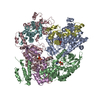 1k90S S: Starting model for refinement |
|---|---|
| Similar structure data |
- Links
Links
- Assembly
Assembly
| Deposited unit | 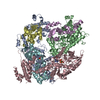
| ||||||||
|---|---|---|---|---|---|---|---|---|---|
| 1 | 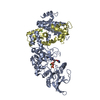
| ||||||||
| 2 | 
| ||||||||
| 3 | 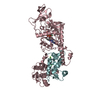
| ||||||||
| Unit cell |
| ||||||||
| Details | The biological assembly is monomer |
- Components
Components
| #1: Protein | Mass: 58810.605 Da / Num. of mol.: 3 / Fragment: c-terminal domain (residues 291-800) Source method: isolated from a genetically manipulated source Source: (gene. exp.)   Bacillus anthracis (anthrax bacterium) / Plasmid: pProEx / Species (production host): Escherichia coli / Production host: Bacillus anthracis (anthrax bacterium) / Plasmid: pProEx / Species (production host): Escherichia coli / Production host:   Escherichia coli BL21 (bacteria) / Strain (production host): BL21 / References: UniProt: P40136, Escherichia coli BL21 (bacteria) / Strain (production host): BL21 / References: UniProt: P40136,  adenylate cyclase adenylate cyclase#2: Protein |  Mass: 16852.545 Da / Num. of mol.: 3 Source method: isolated from a genetically manipulated source Source: (gene. exp.)   Homo sapiens (human) / Species (production host): Escherichia coli / Production host: Homo sapiens (human) / Species (production host): Escherichia coli / Production host:   Escherichia coli BL21 (bacteria) / Strain (production host): BL21 / References: UniProt: P02593, UniProt: P0DP23*PLUS Escherichia coli BL21 (bacteria) / Strain (production host): BL21 / References: UniProt: P02593, UniProt: P0DP23*PLUS#3: Chemical |  Ytterbium Ytterbium#4: Chemical | #5: Chemical | ChemComp-CA / |
|---|
-Experimental details
-Experiment
| Experiment | Method:  X-RAY DIFFRACTION / Number of used crystals: 1 X-RAY DIFFRACTION / Number of used crystals: 1 |
|---|
- Sample preparation
Sample preparation
| Crystal | Density Matthews: 3.69 Å3/Da / Density % sol: 66.71 % |
|---|---|
Crystal grow | Temperature: 298 K / Method: vapor diffusion, hanging drop / pH: 6.5 Details: PEG 8000, ammonium sulfate, glycerol, pH 6.5, VAPOR DIFFUSION, HANGING DROP, temperature 298K |
| Crystal grow | *PLUS Method: unknownDetails: Hiratsuka, T., (1983) Biochem. Biophys. Acta., 742, 496. |
-Data collection
| Diffraction | Mean temperature: 200 K |
|---|---|
| Diffraction source | Source:  SYNCHROTRON / Site: SYNCHROTRON / Site:  APS APS  / Beamline: 14-BM-C / Wavelength: 1 Å / Beamline: 14-BM-C / Wavelength: 1 Å |
| Detector | Type: ADSC QUANTUM 4 / Detector: CCD |
| Radiation | Monochromator: Graphite / Protocol: SINGLE WAVELENGTH / Monochromatic (M) / Laue (L): M / Scattering type: x-ray |
| Radiation wavelength | Wavelength : 1 Å / Relative weight: 1 : 1 Å / Relative weight: 1 |
| Reflection | Resolution: 3.5→29.96 Å / Num. all: 39156 / Num. obs: 38841 / % possible obs: 99.4 % / Observed criterion σ(F): 2 / Observed criterion σ(I): 2 / Redundancy: 7 % / Biso Wilson estimate: 46.7 Å2 / Rmerge(I) obs: 0.083 / Net I/σ(I): 26 |
| Reflection shell | Resolution: 3.6→3.73 Å / Redundancy: 7 % / Rmerge(I) obs: 0.356 / Mean I/σ(I) obs: 10 / Num. unique all: 3871 / % possible all: 99.9 |
| Reflection | *PLUS Highest resolution: 3.6 Å / Redundancy: 6.85 % |
- Processing
Processing
| Software |
| ||||||||||||||||||||||||||||||||||||
|---|---|---|---|---|---|---|---|---|---|---|---|---|---|---|---|---|---|---|---|---|---|---|---|---|---|---|---|---|---|---|---|---|---|---|---|---|---|
| Refinement | Method to determine structure : :  FOURIER SYNTHESIS FOURIER SYNTHESISStarting model: pdb entry 1K90 Resolution: 3.6→29.96 Å / Rfactor Rfree error: 0.007 / Data cutoff high absF: 457541.92 / Data cutoff high rms absF: 457541.92 / Isotropic thermal model: RESTRAINED / Cross valid method: THROUGHOUT / σ(F): 2 / Stereochemistry target values: Engh & Huber
| ||||||||||||||||||||||||||||||||||||
| Solvent computation | Solvent model: FLAT MODEL / Bsol: 51.5231 Å2 / ksol: 0.25238 e/Å3 | ||||||||||||||||||||||||||||||||||||
| Displacement parameters | Biso mean: 81.6 Å2
| ||||||||||||||||||||||||||||||||||||
| Refine analyze |
| ||||||||||||||||||||||||||||||||||||
| Refinement step | Cycle: LAST / Resolution: 3.6→29.96 Å
| ||||||||||||||||||||||||||||||||||||
| Refine LS restraints |
| ||||||||||||||||||||||||||||||||||||
| LS refinement shell | Resolution: 3.6→3.83 Å / Rfactor Rfree error: 0.019 / Total num. of bins used: 6
| ||||||||||||||||||||||||||||||||||||
| Xplor file |
| ||||||||||||||||||||||||||||||||||||
| Refinement | *PLUS Highest resolution: 3.6 Å / % reflection Rfree: 5 % | ||||||||||||||||||||||||||||||||||||
| Solvent computation | *PLUS | ||||||||||||||||||||||||||||||||||||
| Displacement parameters | *PLUS | ||||||||||||||||||||||||||||||||||||
| Refine LS restraints | *PLUS
|
 Movie
Movie Controller
Controller


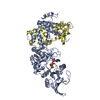
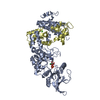

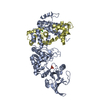
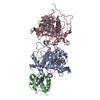
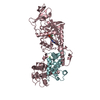
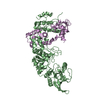
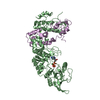
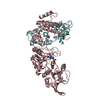

 PDBj
PDBj























